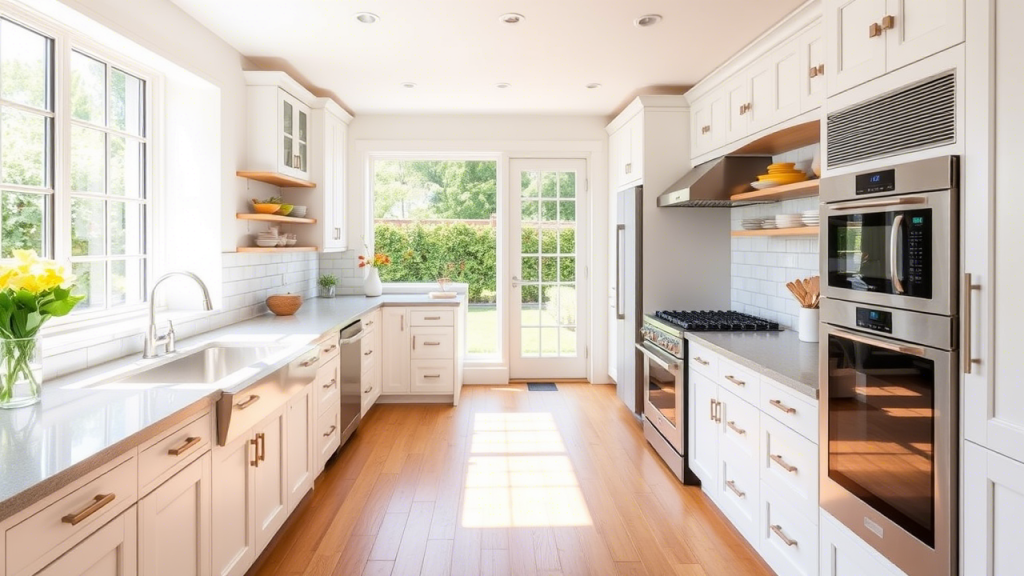Beyond functionality, your kitchen should reflect your personal taste and elevate the atmosphere of your home. The style and aesthetic choices you make—colors, textures, finishes, and fixtures—can dramatically shape the mood of the space, whether you\'re going for cozy and classic or sleek and sophisticated.
Design Styles
Choosing a design style sets the tone for every visual element in your kitchen. It influences everything from cabinet doors and hardware to lighting, color palettes, and finishes. While many kitchens blend multiple styles into a unique hybrid, understanding the core characteristics of popular styles can help you make cohesive, confident design decisions.
Modern
Modern kitchens focus on clean lines, minimal ornamentation, and a streamlined look. They typically feature:
- Flat-panel or slab cabinet doors
- High-gloss or matte finishes
- Integrated or hidden appliances
- Monochromatic or neutral color schemes (white, black, gray)
- Industrial materials like stainless steel, concrete, and glass
This style favors simplicity and functionality, often enhanced by handleless cabinetry, open shelving, and dramatic lighting accents.
Traditional
Rooted in classic architecture and timeless design, traditional kitchens exude warmth and sophistication.
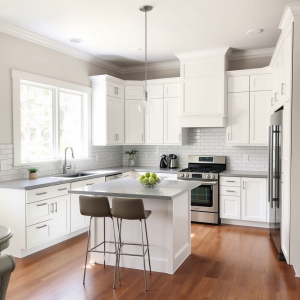 Common elements include:
Common elements include:
- Raised-panel or inset cabinet doors
- Natural wood tones or muted painted finishes
- Ornate moldings, corbels, and trim details
- Antique or vintage-style lighting fixtures
- Rich materials like marble or dark granite
This style often incorporates symmetrical layouts and layers of texture and detailing, offering a sense of history and formality.
Transitional
Transitional kitchens strike a balance between traditional warmth and modern minimalism. They’re versatile and widely popular because they blend old and new in a harmonious way.
Key features:
- Shaker-style or simplified cabinet designs
- Neutral or soft-toned color palettes
- Clean lines with subtle decorative elements
- Mix of natural and manufactured materials
- Understated hardware and lighting
This style works well in homes where the goal is timeless elegance with modern comfort.
Farmhouse
Inspired by rural and vintage charm, farmhouse kitchens emphasize comfort, simplicity, and a welcoming atmosphere.
Defining features include:
- Apron-front (farmhouse) sinks
- Open shelving and glass-front cabinets
- Butcher block or reclaimed wood countertops
- Soft whites, creams, and pastels with natural wood accents
- Rustic or industrial lighting fixtures
This style blends traditional craftsmanship with modern functionality and often includes cozy, family-oriented layouts.
Industrial
Industrial kitchens channel the aesthetic of old factories and commercial kitchens with a bold, edgy look.
Typical elements:
- Exposed brick, pipes, and ductwork
- Metal and concrete finishes
- Matte black or dark-toned cabinetry
- Open shelving with raw wood or steel
- Large pendant lighting and utilitarian hardware
This style is perfect for urban lofts or homeowners looking for an unconventional, statement-making design.
Scandinavian
Known for its simplicity, functionality, and natural beauty, Scandinavian kitchen design prioritizes efficiency and light.
Key traits:
- White or pale-toned color schemes
- Natural wood accents (light oak, birch, or ash)
- Clean, minimal lines and clutter-free surfaces
- Open layouts with lots of natural light
- Subtle texture layering (linen, ceramic, stone)
Scandinavian design promotes calm, airy environments and works especially well in smaller or modern homes.
Each style offers a distinct experience and aesthetic vocabulary. The right choice often depends on the home’s architecture, the owner\'s lifestyle, and the emotional response the kitchen should evoke—whether it’s cozy and nostalgic, bold and modern, or clean and serene.
Color Schemes
Color plays one of the most powerful roles in kitchen design. It can affect mood, create the illusion of space, define style, and highlight architectural features. Whether you\'re aiming for a timeless look or something bold and trend-forward, a well-planned color scheme brings the entire kitchen together cohesively.
Understanding the Role of Color
In kitchen remodeling, color does more than decorate—it guides the eye and influences perception. Lighter shades can make a small kitchen feel open and airy, while darker tones bring depth and sophistication. A balanced palette can highlight materials, add contrast, or unify eclectic elements.
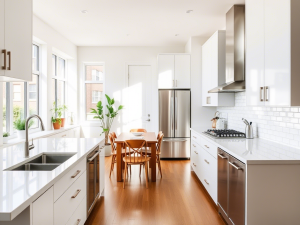
When building a color scheme, designers often rely on a three-part structure:
- Primary color – The dominant tone, used on walls, cabinets, or floors
- Secondary color – Used for accents like backsplashes, islands, or countertops
- Accent color – Adds personality and contrast, typically through decor, hardware, or smaller details
Popular Color Directions
Here are several well-established and emerging directions for kitchen color palettes:
1. Neutral & Timeless
- Whites, creams, beiges, taupes, and grays
- Clean, classic, and flexible over time
- Often paired with natural materials (wood, stone)
- Works well in modern, transitional, and Scandinavian designs
2. Monochromatic Palettes
- Different shades and tints of a single color
- Creates harmony and a sleek, cohesive appearance
- Ideal for minimalist or contemporary styles
3. High Contrast
- Bold pairings like black and white, navy and brass, or charcoal and marble
- Adds drama and dimension to the space
- Common in modern and industrial kitchens
4. Earthy & Organic
- Warm browns, deep greens, muted terracottas, and clay tones
- Evokes calm and connection to nature
- Pairs beautifully with wood textures and matte finishes
5. Bold & Expressive
- Jewel tones (emerald, sapphire, ruby), or vibrant hues (mustard, teal, coral)
- Adds character and uniqueness
- Best used as accent cabinetry, islands, or backsplashes
Cabinet Color Trends
Cabinetry is often the largest visual element in the kitchen, so color selection here carries weight. Current trends include:
- Two-tone cabinets (e.g., darker lowers and lighter uppers)
- Soft greens and blues for a subtle pop of color without overwhelming the space
- Matte black or charcoal for a sleek, dramatic look
- Warm whites and creamy tones for a clean but cozy feel
The Importance of Finishing
Color alone doesn’t define the look—finish makes a huge difference. Matte finishes absorb light for a soft, contemporary vibe, while gloss reflects light and can feel more modern or formal. Satin and semi-gloss offer a balanced, versatile finish with easy maintenance.
Lighting & Color Interaction
Colors will look different depending on your kitchen\'s lighting, both natural and artificial. It’s important to test color swatches in different parts of the room, at various times of day, to ensure they behave as expected under changing conditions.
A carefully chosen color scheme not only supports your kitchen’s style, it elevates it. By harmonizing cabinetry, walls, countertops, and fixtures through intentional use of color, the entire space becomes more cohesive, more welcoming, and more personal.
Lighting Design
Lighting is one of the most underestimated elements in kitchen remodeling, yet it’s essential for both function and atmosphere. A well-lit kitchen enhances usability, highlights key design features, and sets the mood for everything from food prep to entertaining.
Effective lighting isn’t just about brightness—it’s about layering, placement, and purpose.
The Three Layers of Kitchen Lighting
A thoughtfully designed lighting plan typically includes three main layers, each serving a distinct role:
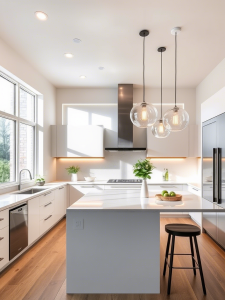
1. Ambient Lighting (General Illumination)
This is the foundational layer, responsible for overall brightness in the space. It fills in shadows and provides consistent light throughout the kitchen.
Common ambient options:
- Recessed ceiling lights
- Flush or semi-flush mounts
- Large central fixtures
Well-distributed ambient lighting ensures that even when natural daylight fades, the kitchen remains safe and usable.
2. Task Lighting (Functional Light)
Task lighting focuses on high-use work areas, such as countertops, the sink, or the stove. Its goal is to reduce shadows and provide direct, concentrated light where precision is key.
Popular task lighting solutions include:
- Under-cabinet LED strips or puck lights
- Pendant lights over islands or peninsulas
- Directional track lights
This layer is essential for cooking, chopping, and cleaning without eye strain.
3. Accent Lighting (Decorative & Mood Enhancing)
Accent lighting adds depth and visual interest, helping to highlight architectural details or enhance ambiance.
Accent options might include:
- LED toe-kick lighting at the base of cabinets
- Above-cabinet uplighting
- Glass cabinet interior lighting
- Decorative pendants or sconces
Used strategically, accent lighting can make the kitchen feel warm, layered, and thoughtfully designed.
Choosing Fixtures by Style
Lighting fixtures are not just functional—they\'re also design statements. Choose styles that reinforce your kitchen’s aesthetic:
- Modern kitchens often feature sleek, minimalist pendants or integrated LED solutions.
- Traditional kitchens may lean toward vintage-inspired sconces, chandeliers, or ornate glass pendants.
- Industrial kitchens pair well with black metal fixtures, cage designs, or oversized bulbs.
- Transitional styles benefit from classic silhouettes with updated finishes like brushed brass or matte black.
Light Temperature & Bulb Selection
The color temperature of your bulbs also impacts how your kitchen feels:
- Warm White (2700K–3000K): Creates a cozy, inviting glow. Ideal for accent and ambient lighting.
- Cool White (3500K–4100K): Crisp and clean. Works well in task areas.
- Daylight (5000K+): Bright and energizing, but can feel clinical if overused.
LED bulbs are preferred for their energy efficiency, longevity, and ability to work with dimmers and smart systems.
Smart Lighting Integration
Smart lighting systems are becoming increasingly common in modern kitchen remodels. These allow users to:
- Adjust brightness and color temperature via app or voice control
- Set lighting “scenes” for cooking, dining, or entertaining
- Automate schedules for energy savings and convenience
When planned from the start, smart lighting can be seamlessly integrated into your overall kitchen design.
A well-lit kitchen not only improves visibility, but it also enhances comfort, safety, and ambiance. The right lighting transforms your kitchen from a utilitarian space into one that’s dynamic and emotionally engaging, no matter the time of day.
Backsplash Options
The backsplash is one of the most expressive design elements in any kitchen. While its primary function is to protect the wall from moisture, grease, and food splatter, it also plays a critical role in the kitchen’s overall aesthetic, whether it’s a subtle complement or a bold focal point, the right backsplash ties together cabinetry, countertops, and hardware to create a cohesive design.
Common Materials
Each backsplash material brings its own blend of style, durability, and maintenance requirements. Here are some of the most popular choices:
1. Ceramic & Porcelain Tile
- Affordable and widely available
- Comes in countless shapes, colors, and patterns
- Easy to clean and maintain
- Great for both classic and contemporary designs
2. Glass Tile
- Reflects light beautifully, adding brightness
- Resistant to stains and mildew
- Often used in mosaics or subway styles
- Can show smudges and fingerprints more easily
3. Natural Stone (Marble, Granite, Slate, Travertine)
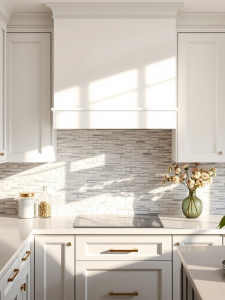
- Adds luxury and texture
- Each piece is unique in color and veining
- Requires sealing and regular maintenance
- Best suited for upscale or traditional kitchens
4. Metal (Stainless Steel, Copper, Brushed Aluminum)
- Sleek, industrial look
- Heat and stain resistant
- Common in modern or commercial-style kitchens
- May scratch or dent more easily than tile
5. Quartz or Solid Surface
- Seamless continuation of countertop material
- Easy to clean with a minimalistic look
- More expensive due to fabrication
- Great for modern and transitional spaces
6. Peel-and-Stick or Laminate Panels
- Budget-friendly and DIY-friendly
- Wide range of finishes, from faux tile to metallic
- Not as durable as tile or stone
- Best for quick refreshes or rental properties
Patterns & Layouts
The arrangement of your backsplash can dramatically influence the visual feel of the space. Some popular patterns include:
- Subway (Horizontal or Vertical Stacked): Clean, timeless, and versatile
- Herringbone: Adds dynamic movement and visual texture
- Chevron: Similar to herringbone, but with a cleaner V shape
- Hexagonal or Geometric Tiles: Modern and eye-catching
- Mosaic: Great for accent walls or niches; adds depth and complexity
- Full Slab Backsplash: A single slab of stone or quartz for a seamless, luxurious look
Color & Finish Considerations
- Light-colored backsplashes can open up the space and make it feel fresh and airy
- Dark or bold colors add contrast and sophistication
- Glossy finishes reflect light and are easier to clean
- Matte finishes are subtle and modern, though slightly more prone to staining
When choosing a backsplash, consider how it interacts with your countertops, cabinets, and lighting. The backsplash can either blend in or become a focal point—what matters is that it supports your design intent.
Practical Tips
- Always seal porous materials like natural stone to prevent staining
- Use grout with stain resistance or sealant for easier maintenance
- Run the backsplash to the underside of upper cabinets—or to the ceiling for a more dramatic effect
- Under-cabinet lighting can enhance the color and texture of your backsplash
The right backsplash is more than just a protective surface—it’s an opportunity to express your style and tie the kitchen’s visual elements together with purpose and polish.
Decor & Finishing Touches
While the layout, cabinetry, and materials form the backbone of a kitchen remodel, it\'s the finishing touches that bring warmth, character, and personal style to the space. These details are often the most overlooked, but they’re also the most powerful when it comes to transforming a kitchen from functional to finished.
Hardware Selections
Cabinet hardware is like jewelry for the kitchen. It enhances cabinetry style and subtly reinforces your design theme.
- Finishes: Popular choices include matte black, brushed nickel, oil-rubbed bronze, satin brass, and chrome.
- Styles: Choose from modern bar pulls, traditional knobs, vintage cup pulls, or minimalist finger grooves.
- Mixing Metals: When done thoughtfully, mixing metals (e.g., black pulls with brass light fixtures) adds depth and visual interest.
Decorative Elements
Once the core features are installed, layered decor brings the space to life:
- Open Shelving: Ideal for displaying cookbooks, plants, or curated dishware.
- Wall Art or Prints: Adds personality and visual breaks in larger kitchens.
- Rugs & Runners: Provide warmth and color while softening high-traffic zones.
- Window Treatments: Roman shades, woven woods, or minimalist blinds for light control and style.
Greenery & Natural Touches
Plants and natural textures have become essential elements in modern kitchen design:
- Herb Gardens: Fresh basil, rosemary, and thyme can be grown in small countertop planters or wall-mounted racks.
- Wood Accents: Cutting boards, butcher blocks, and wooden utensils introduce warmth and contrast.
Personalization
The finishing stage is the time to reflect you —your tastes, habits, and lifestyle. Whether it’s a custom coffee station, a wine rack, a chalkboard wall for family notes, or handmade pottery, these final choices make the kitchen feel truly lived-in and loved.
At Jerry Polich Construction LLC, we believe the details are where a kitchen remodel becomes yours. Our team works closely with you to ensure every element—from drawer handles to shelf styling—aligns with your vision. We take pride in helping clients move beyond basic renovation into fully personalized, functional, and beautiful spaces. Contact us today to schedule your Free consultation and take the first step toward a kitchen that’s as functional as it is beautiful.
Remember, your dream Kitchen is just a phone call away. Don’t wait—contact us now for a free consultation and let’s start your transformation today!

